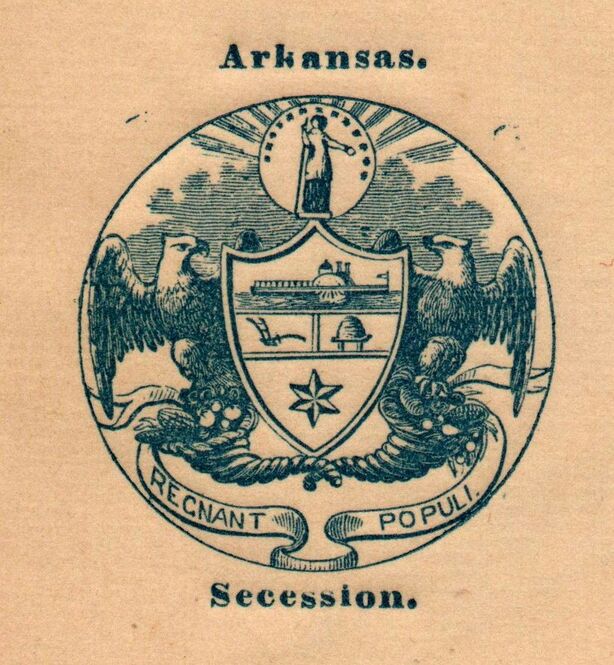Unexpected Battle At Pea Ridge (1861)
Written by J. Dickson Black - time frame unknown (Circa 1950s?) Possibly this may never have been published.
Written by J. Dickson Black - time frame unknown (Circa 1950s?) Possibly this may never have been published.
This story of a small battle in Pea Ridge, a year before the Civil War battle there, has been told by several people writing about that time. It was best told by Col. J. H. VanHoose, of Fayetteville, in an article he wrote for the Arkansas Sentinel in 1890.
"In the early part of the spring of 1861, Col. E. C. Boudinot of Fort Smith, who was then one of the editors of the Arkansian, a newspaper published in Fayetteville, was called to Bentonville on business, and while there was called on to deliver an address on the great question then agitating this country, viz; The probable effect of the election of Abraham Lincoln. During that address, he alluded in a very eloquent manner to the American eagle and other insignia of the power and glory of our country and regretted the conflict between the North and the South about to come upon us.
"After he had finished his speech an old farmer who lived near Elk Horn Tavern, came to him and said, 'I want to tell you what happened on my farm only a few days ago. Me and my boy were plowing the field about 12 o'clock the other day, when we heard a roaring and whirring noise in the air above us. Looking up we saw off, though directly above what appeared to be a struggling bird of enormous size. It came nearer and nearer in a slanting direction until it struck the ground with a heavy thud. To our astonishment it separated, and we beheld the largest owl I ever saw and of a different species fron any ever seen in this country, and a magnificent gray eagle.
"The owl had fastened its huge talons in the eagle's breast, and as they struck the earth they loosened their hold upon each other not more than twenty feet from us and layed exhausted.
"We captured both, though the eagle fought like a wildcat: the owl died about an hour after its capture. I have the eagle and I will give him to you for the speech of yours, if you will go home with me.
"Col. Boudinot went, secured the prize, brought it home with him and gave it to Col. J. M. Tibbets, who then lived in his home where C. W. Walker now lives on College Avenue in Fayetteville.
"In the early part of the spring of 1861, Col. E. C. Boudinot of Fort Smith, who was then one of the editors of the Arkansian, a newspaper published in Fayetteville, was called to Bentonville on business, and while there was called on to deliver an address on the great question then agitating this country, viz; The probable effect of the election of Abraham Lincoln. During that address, he alluded in a very eloquent manner to the American eagle and other insignia of the power and glory of our country and regretted the conflict between the North and the South about to come upon us.
"After he had finished his speech an old farmer who lived near Elk Horn Tavern, came to him and said, 'I want to tell you what happened on my farm only a few days ago. Me and my boy were plowing the field about 12 o'clock the other day, when we heard a roaring and whirring noise in the air above us. Looking up we saw off, though directly above what appeared to be a struggling bird of enormous size. It came nearer and nearer in a slanting direction until it struck the ground with a heavy thud. To our astonishment it separated, and we beheld the largest owl I ever saw and of a different species fron any ever seen in this country, and a magnificent gray eagle.
"The owl had fastened its huge talons in the eagle's breast, and as they struck the earth they loosened their hold upon each other not more than twenty feet from us and layed exhausted.
"We captured both, though the eagle fought like a wildcat: the owl died about an hour after its capture. I have the eagle and I will give him to you for the speech of yours, if you will go home with me.
"Col. Boudinot went, secured the prize, brought it home with him and gave it to Col. J. M. Tibbets, who then lived in his home where C. W. Walker now lives on College Avenue in Fayetteville.
This is an image off a Union envelope from the Civil War era
"Col. Tibbets was a strong Union man, as were many of Fayetteville's good citizens at that time, believing it unwise for the southern states to secede as South Caroline had already done: and he and his friends felt proud of "the old bird of liberty" and sympathized with it in its captivity. Col. Tibbets provided a roomy cage for it and it was fed the best the market afforded. It received many calls from the gentlemen and ladies of Fayetteville.
"It was indeed a drawing card and, although Col Tibbets and his accomplished wife and daughter were very popular in Fayetteviile society, they received many calls from those who came out of curiosity to see the once-proud bird.
"The old eagle seemed to know that although deprived of his liberty, he yet had a friend in Col Tibbets and the sympathy of all who came to see him. This proud captive was kept and well cared for until May 7, 1861, on which day news was receieved, by wire, that the State Convention, then in session in Little Rock, had on the previous day passed the ordinance of secession and declared Arkansas no longer one of the United States. I think it was on the afternoon of that day, as well as I now remember, but at any rate it was soon after secession, that Col. Tibbets opened the prison door and addressing his captive, said 'Go, proud-bird of liberty, thou art free."
"The old eagle stepped out, spread its wings, and rose over the house top and made his way to the Female Institute building (which was a very nice two story and a half edifice, standing on the west side of College Avenue near where Charles W, Trott's dwelling now stands) and alighted on top of its cupola, where he set, picking himself and getting his bearings. After resting a few moments, he stretched his wings and soared into the unknown."
This was all of Mr. VanHooses's article. Several others who wrote of this bird said it was thought to be an oman of the outcome of the upcoming war.
The eagle standing for the Union and they said that they knew that the Union would win the war just as the eagle had won his battle with the large owl.
"It was indeed a drawing card and, although Col Tibbets and his accomplished wife and daughter were very popular in Fayetteviile society, they received many calls from those who came out of curiosity to see the once-proud bird.
"The old eagle seemed to know that although deprived of his liberty, he yet had a friend in Col Tibbets and the sympathy of all who came to see him. This proud captive was kept and well cared for until May 7, 1861, on which day news was receieved, by wire, that the State Convention, then in session in Little Rock, had on the previous day passed the ordinance of secession and declared Arkansas no longer one of the United States. I think it was on the afternoon of that day, as well as I now remember, but at any rate it was soon after secession, that Col. Tibbets opened the prison door and addressing his captive, said 'Go, proud-bird of liberty, thou art free."
"The old eagle stepped out, spread its wings, and rose over the house top and made his way to the Female Institute building (which was a very nice two story and a half edifice, standing on the west side of College Avenue near where Charles W, Trott's dwelling now stands) and alighted on top of its cupola, where he set, picking himself and getting his bearings. After resting a few moments, he stretched his wings and soared into the unknown."
This was all of Mr. VanHooses's article. Several others who wrote of this bird said it was thought to be an oman of the outcome of the upcoming war.
The eagle standing for the Union and they said that they knew that the Union would win the war just as the eagle had won his battle with the large owl.

